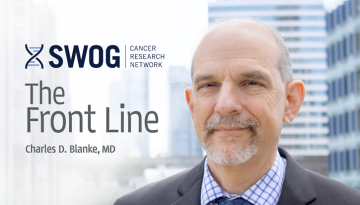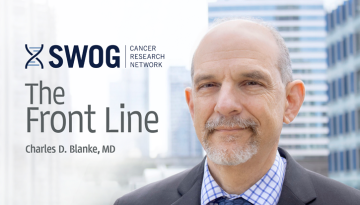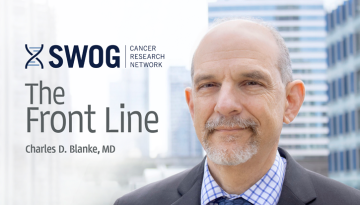SWOG Research Shines at SABCS 2022
Researchers from the SWOG Cancer Research Network, a cancer clinical trials group funded by the National Cancer Institute (NCI), part of the National Institutes of Health (NIH), will present 10 abstracts at this year’s San Antonio Breast Cancer Symposium. Here are some highlights from this research.
• Adding a year of everolimus to adjuvant endocrine therapy did not improve IDFS or OS in HR+, HER2- breast cancer (SWOG S1207 trial) (GS1-07)
Patients with hormone receptor-positive (HR+), HER2-negative breast cancer who are at high risk for recurrence are often treated with chemotherapy and endocrine therapy after surgery. Despite this, some patients continue to experience breast cancer recurrence.
The randomized, phase III SWOG S1207 trial tested whether adding one year of the drug everolimus to adjuvant endocrine therapy that started after completion of chemotherapy could extend invasive disease-free survival (IDFS) and overall survival (OS).
S1207 researchers found that overall, one year of everolimus did not improve IDFS or OS times, and that it was associated with a lower treatment-completion rate and an increased rate of adverse events (side effects) compared to placebo. Among premenopausal patients, however, those who received everolimus had statistically significantly longer IDFS and OS.
GS1-07 will be given as an oral presentation by Mariana Chavez Mac Gregor, MD, MSc, of The University of Texas MD Anderson Cancer Center, on Tuesday, December 6.
• Two out of three patients on taxanes for breast cancer experienced neuropathy during first year of treatment (PD8-06)
SWOG study S1714 evaluated taxane chemotherapy-induced peripheral neuropathy – numbness, tingling, and/or burning in the extremities – in patients being treated for a variety of cancers.
Researchers will report at SABCS 2022 that of the 1,198 patients being treated for breast cancer on S1714 (56.2 percent of whom were treated with paclitaxel and 43.8 percent with docetaxel), two-thirds (67.8 percent) reported clinically meaningful sensory neuropathy at one or more time points during their first year of treatment. Moreover, almost one-half continued to experience symptoms of neuropathy by the end of the first year. Of particular note, the breast cancer cohort were quite racially/ethnically diverse: 79 percent White, 12.8 percent Black, 5.4 percent Asian, and 11.1 percent Hispanic/Latino.
Meghna S. Trivedi, MD, MS, of Columbia University/ Herbert Irving Comprehensive Cancer Center, will present poster PD8-06 in a spotlight poster discussion on Wednesday, December 7.
• Patients with Medicare plus Medicaid had higher rates of unplanned ER use than others with Medicare (PD6-04)
A team of SWOG cancer care delivery researchers analyzed clinical and insurance data on patients treated on SWOG clinical trials from 2006 to 2019 who were over the age of 65 and had breast cancer.
Patients who were insured by Medicare plus Medicaid were compared as a group to patients insured by Medicare alone or by Medicare plus commercial insurance. These Medicare-plus-Medicaid patients were almost twice as likely as other Medicare patients to have unplanned emergency room visits (51 percent versus 27.7 percent) during the first 12 months after registering to a clinical trial.
Researchers controlled for patients’ clinical, demographic, and prognostic factors. Analyzing data specifically from clinical trial participants also helped them control for other confounding factors, as those enrolled to trials have similar access to supportive care and are treated uniformly according to a strict protocol. The researchers suggest insurance status may be a proxy for structural barriers to outpatient quality care.
Dawn L. Hershman, MD, MS, of Columbia University will present poster PD6-04 in a spotlight poster discussion on Wednesday, December 7.
Both of the following SABCS abstracts build on data from the S1007 RxPONDER trial. RxPONDER enrolled more than 5,000 women with hormone receptor-positive, HER2-negative breast cancer who had one to three involved lymph nodes and a 21-gene recurrence score (RS) of 25 or less. Participants were randomly assigned to receive either adjuvant (post-surgery) chemotherapy followed by endocrine therapy or adjuvant endocrine therapy alone. Primary results were reported at a previous SABCS and in the New England Journal of Medicine late last year.
• Cancer-related cognitive impairment is greater with chemo-endocrine therapy than with endocrine therapy alone (GS1-04)
RxPONDER compared treatment with chemotherapy plus endocrine therapy to treatment with endocrine therapy alone. For this SABCS abstract, researchers compared patient-reported cognitive impairment over time across RxPONDER’s two arms and by patient menopausal status.
They asked a subset of patients to complete the PROMIS Perceived Cognitive Function Concerns Short Form questionnaire, a brief self-assessment of cognitive abilities, at randomization and then 6 months, 12 months, and 36 months later.
They found that, on average, patients on both arms tended to suffer cognitive impairment at the 6-month and 12-month marks during treatment. However, by 36 months, patients on the endocrine therapy-only arm had recovered baseline cognitive function, while for those who received both endocrine therapy and chemotherapy, mean scores remained below baseline levels at 36 months.
Irene M. Kang, MD, of City of Hope, will deliver the results in an oral presentation on Tuesday, December 6 (presentation GS1-04).
• HER2-low status had no effect on improvement across treatment groups and menopausal status (P6-01-21)
Many breast cancer tumors classified as HER2-negative actually contain low levels of the HER2 protein. “HER2-low” breast cancer is defined as having a HER2 expression level of 1+ or 2+, as measured by immunohistochemistry, without HER2 gene amplification.
SWOG researchers evaluated the effect of HER2-low status on RxPONDER patient outcomes across treatments and by menopausal status.
HER2 status was available for 4,588 RxPONDER patients. Among premenopausal women, 52 percent had HER2-low breast cancer; the rate was 57 percent among postmenopausal women.
Researchers found no statistical imbalance between treatment group (chemo-endocrine therapy versus endocrine therapy alone) and HER2-low status. They also found that HER2-low status was not independently associated with worse invasive disease-free survival compared to HER2-zero status.
Laura Spring, MD, of Dana Farber/Harvard Cancer Center, will present the results in a poster session on Friday, December 9 (poster P6-01-21).
The work described above was supported by the NCI, led by SWOG, and conducted by the NIH-funded National Clinical Trials Network (NCTN) and the NCI Community Oncology Research Program (NCORP).
This research has been funded by the NIH/NCI through grants U10CA180888, U10CA180819, U10CA180820, U10CA180821, U10CA180822, U10CA180868, U10CA180863, and UG1CA189974. Other support for the work in one or more of these abstracts has been provided by Susan G. Komen for the Cure Research Program, The Hope Foundation for Cancer Research, Breast Cancer Research Foundation, Exact Sciences Corporation (formerly Genomic Health, Inc.), the American Cancer Society, and Novartis Pharmaceuticals Corporation.
Other Recent Stories



